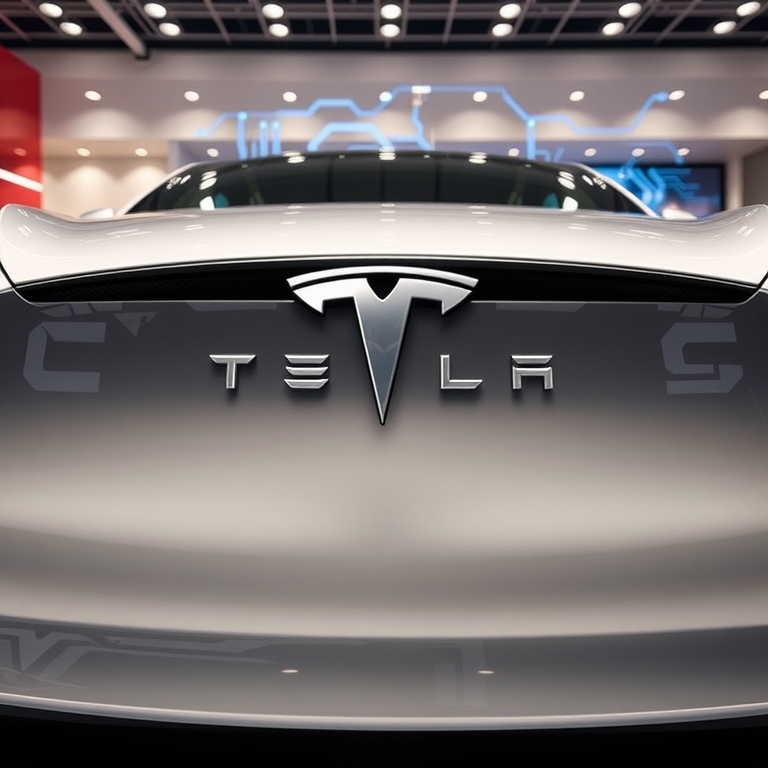In the competitive landscape of the automotive industry, few emblems have captured the public’s imagination quite like the Tesla logo. Sleek, minimalist, and instantly recognizable, this emblem is more than just a corporate insignia. It stands as a symbol of groundbreaking innovation and the relentless pursuit of technological advancement in the realm of electric vehicles. Over the past decade, Tesla has not only transformed the automotive industry but has also set new benchmarks for sustainability, performance, and design. The emblematic “T” of Tesla is often seen as a beacon of these values, representing a company that has dared to defy conventions and redefine what is possible.
The story of Tesla’s logo is deeply intertwined with its mission to accelerate the world’s transition to sustainable energy. The design, at first glance, might appear to simply depict the letter “T,” but it holds a deeper engineering significance. According to some interpretations, the Tesla logo is inspired by the cross-section of an electric motor, a nod to Nikola Tesla’s innovations and the company’s roots in electric propulsion. This subtle yet profound connection to the core technology that powers Tesla vehicles is a testament to the company’s commitment to engineering excellence.
Tesla’s rise to prominence is a narrative driven by visionary leadership and a bold approach to problem-solving. Under the guidance of CEO Elon Musk, Tesla has not only popularized electric vehicles (EVs) but has also challenged traditional automakers to rethink their approach to vehicle design and energy consumption. The Tesla logo, therefore, is not merely a brand identifier; it is a representation of a paradigm shift in the automotive sector. It signifies a commitment to a future where transportation is not only cleaner but also smarter.
The company’s approach to innovation extends far beyond its logo. Tesla’s vehicles are equipped with cutting-edge technology that redefines the driving experience. From Autopilot, an advanced driver-assistance system, to over-the-air software updates that continually enhance vehicle performance, Tesla is at the forefront of integrating technology with transportation. The logo, in this context, symbolizes a fusion of elegance and sophistication with high-tech prowess, a promise of what modern mobility can achieve.
Tesla’s commitment to innovation is further exemplified by its Gigafactories, sprawling facilities designed to produce batteries and vehicles at an unprecedented scale. These factories are a crucial component of Tesla’s strategy to drive down costs and make electric vehicles accessible to a broader audience. The logo, therefore, can also be seen as an emblem of scalability and efficiency, reflecting the company’s ambition to not just participate in the electric revolution but to lead it.
The impact of Tesla’s innovation is evident in the market’s response. Tesla has consistently been at the forefront of electric vehicle sales, and its market valuation reflects investor confidence in its vision and execution. The Tesla logo has become synonymous with a brand that is not just a car manufacturer but a leader in the clean energy movement. This reputation has helped Tesla cultivate a loyal customer base that is as passionate about the company’s mission as it is about its products.
Moreover, the Tesla logo embodies a narrative of aspiration and achievement. It is a reminder that great innovation often requires taking significant risks. Tesla’s journey has been marked by challenges, from production bottlenecks to skepticism from traditional automakers. Yet, each challenge has been met with a resolve to innovate and improve. The logo, thus, represents resilience and determination, qualities that have enabled Tesla to not only survive but thrive in an industry known for its barriers to entry.
In the broader context of sustainability, Tesla’s logo also serves as a symbol of environmental stewardship. The company’s vehicles contribute to reducing greenhouse gas emissions and dependence on fossil fuels, aligning with global efforts to combat climate change. Tesla’s energy products, such as solar panels and energy storage solutions, complement its vehicle lineup, offering a holistic approach to sustainable living. The logo, therefore, is more than a corporate symbol; it is a badge of commitment to creating a sustainable future.
The influence of Tesla’s logo extends beyond the automotive industry. It has inspired a new generation of entrepreneurs and innovators who see in Tesla a model for how technology can be leveraged to solve some of the world’s most pressing challenges. The logo has become a rallying point for those who believe in the power of innovation to drive progress and change. It is a symbol of the potential that lies in marrying vision with technology, a testament to what can be achieved when one dares to dream big and defy the status quo.
In conclusion, the Tesla logo is more than a simple design; it is a powerful emblem of innovation and technological advancement in the electric vehicle industry. It encapsulates the spirit of a company that has not only transformed transportation but has also set in motion a broader movement toward sustainable living. As Tesla continues to push the boundaries of what is possible, its logo will remain a symbol of the company’s enduring legacy and its ongoing quest to shape the future of mobility.
